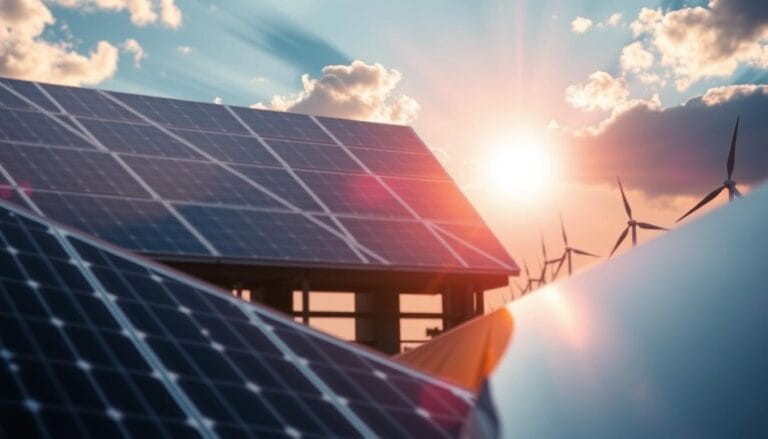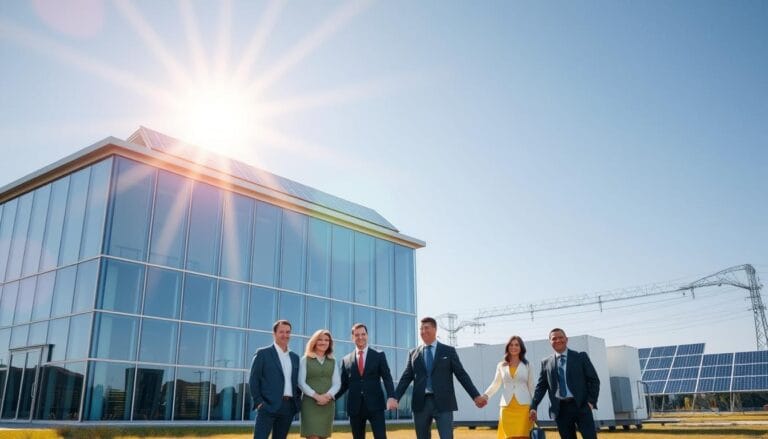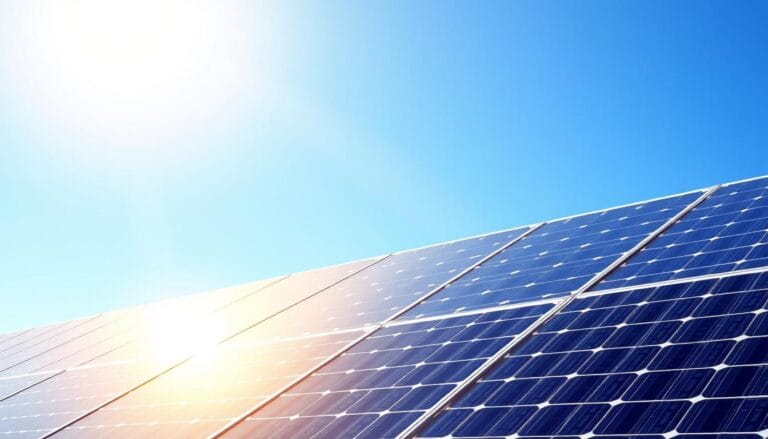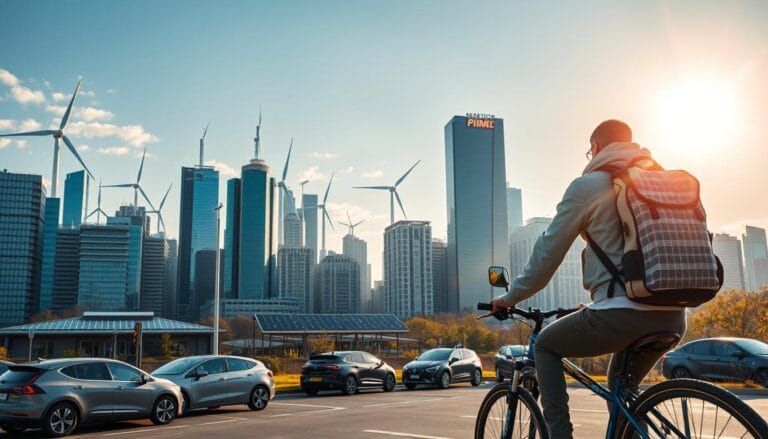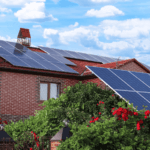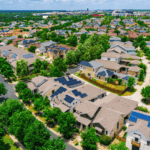We are at a critical point where climate challenges meet technological innovation. Sustainable energy solutions are leading the way to a resilient future. BPi has been a key player in this journey since 2008. It combines green technology and advanced engineering to help commercial properties use renewable power sources.
BPi holds a valuable License #930054. It offers a wide range of services, from solar-efficient roofs to cutting-edge battery systems. The company leads projects across the country. It brings renewable energy solutions to commercial properties, making them more sustainable and cutting costs.
Key Takeaways
- BPi’s extensive range of tailored sustainable energy solutions.
- Impacts of BPi’s green technology on commercial properties, including utility cost reduction and property value enhancement.
- The significance of an integrated, client-focused approach to solar solution implementation.
- BPi’s strong track record, bolstered by a full-service model encompassing project management to performance monitoring.
- Nationwide presence and commitment to driving the adoption of renewable power sources across various industry segments.
The Critical Role of Energy in Climate Change
The link between energy production and climate change is clear. Our choices today affect the future of our planet. Switching to carbon-neutral power is key to cutting down on greenhouse gas emissions.
Impact of Fossil Fuels on Greenhouse Gas Emissions
Fossil fuels like coal, oil, and gas have driven industrial growth but at a big environmental cost. They make up over 75% of global greenhouse gas emissions, with most carbon dioxide coming from them. Using these fuels increases global warming and climate change, making a shift to sustainable energy crucial.
Global Targets for Emission Reductions
International groups and governments have set big goals to fight climate change. They aim to cut emissions in half by 2030 and reach net-zero by 2050. These goals push for renewable energy, which helps meet these climate goals without hurting the world’s energy needs.
Scientific Consensus on Renewable Power Sources
Scientists agree that renewable energy like solar, wind, and hydropower are key to fighting climate change. These sources are safer for the planet than fossil fuels. New tech has made them more efficient, making them a good choice for the world’s energy needs.
- Now, renewable energy like solar and wind make up 29% of the world’s electricity, showing a big move towards sustainable energy.
- Studies say renewable energy could create millions of jobs, helping the economy and protecting the environment.
- Investing in efficient appliances and grid tech is cutting our carbon footprint and helping us switch to cleaner energy.
The facts are clear: choosing renewable energy and going for carbon-neutral solutions is vital. It’s not just for cutting emissions but also for economic stability and a healthier planet for the future.
Revolutionizing Energy with Green Technology
In today’s world, green energy, energy efficiency, and clean technology are key to changing how we use energy. Thanks to new tech, we’re using less fossil fuel and moving towards a greener future.
Big steps forward have been made in solar and wind energy. Solar panels now turn more sunlight into energy, and wind turbines catch more wind. These changes show how clean technology is making a big difference for the planet.
| Technology | Advancements | Impact |
|---|---|---|
| Solar Panels | High efficiency through improved photovoltaic cells | Reduces production costs and increases accessibility |
| Wind Turbines | Enhanced aerodynamics, larger sizes | Minimizes operational costs, maximizes output |
| Eco-Friendly Innovations | Perovskite solar cells, floating wind farms | Opens new avenues for clean energy generation |
| Energy Storage Solutions | Advanced batteries, compressed air systems | Improves grid reliability and energy availability |
Solar Powers World, led by Forhad Khan, is leading the way in solar technology. They focus on making energy use both efficient and green. This work helps solve today’s environmental and health issues and sets us up for a sustainable future.
The cost of solar and wind power is dropping, making them more competitive in the market. Governments need to support this growth with policies and incentives. This will help the sector meet the world’s growing energy needs in a responsible way.
Green energy does more than protect the environment; it also creates jobs, stabilizes the economy, and ensures energy security. As we keep innovating and using these technologies, we’re getting closer to a sustainable energy model. This model promises a cleaner, more secure future for everyone.
In conclusion, the changes brought by clean technology in solar and wind energy are huge and vital. By adopting these green solutions, we’re building a sustainable future. This ensures that making energy and protecting the environment go together.
Sustainable Energy: A Path to Environmental Sustainability
Using sustainable power generation is key to cutting down our ecological footprint. By choosing alternative energy resources, we help the planet and lead the way to true sustainability. This change is vital for meeting both economic and environmental goals, ensuring growth and resource use are balanced.
Decoupling Energy Production and Environmental Degradation
New technologies in sustainable power generation can greatly reduce the harm energy production usually causes to the environment. By using solar, wind, and hydroelectric power, we can cut down on harmful emissions. This helps improve the environment and supports sustainability.
Renewable Power Sources as a Sustainable Alternative
Renewable energy is a strong choice compared to fossil fuels. It offers a steady energy supply with little harm to the environment. These sources protect nature and help the economy by being less affected by market changes than traditional energy sources.
Thanks to new tech and lower costs, renewable energy is now more appealing for people and businesses. Big names like Google and Microsoft aim to use 100% renewable energy and go carbon negative by 2030. Their goals show how renewable energy is key for sustainable power and corporate responsibility for the planet.
Here are some stats that highlight the good things about moving to renewable energy:
| Benefit | Impact |
|---|---|
| Lower greenhouse gas emissions | Significant reduction in environmental footprint |
| Energy cost reduction | Decreased operational costs over time |
| Increased energy security | Less dependency on imported fuels |
| Enhanced business resilience | Less vulnerability to fuel price volatility |
| Positive corporate image | Improved stakeholder and investor relations |
The future of energy doesn’t have to harm our planet. By choosing renewable and sustainable power, we create a future that cares for our planet. This way, we ensure our ecological systems are safe for generations to come.
Eco-Friendly Electricity: Benefits Beyond the Environment
Switching to eco-friendly energy is good for the planet and people. It helps reduce pollution from fossil fuels. This change is urgent for our health and economy.
Health Advantages of Clean Energy Solutions
Using environmentally friendly energy cuts down on air pollution. This pollution can cause lung and heart diseases. By moving to renewable energy, we reduce smog and harmful particles in the air.
For example, hydro, solar, and wind power are much cleaner than coal. They release 60-90% fewer pollutants that are bad for us.
Social and Economic Impacts of Renewable Energy
Switching to renewable energy benefits also helps the economy. Investing in things like wind and solar creates more jobs than fossil fuels. In fact, every dollar spent on renewables can create three times as many jobs.
By 2030, renewable energy could lead to 30 million new jobs. This would boost the economy and make it more stable.
Going green also helps the economy in the long run. It reduces the need for imported fuels, making our energy more secure. Plus, it could save up to $4.2 trillion a year by 2030. This is from cutting down on health and environmental damage from fossil fuels.
| Economic Factor | Impact of Renewable Energy |
|---|---|
| Job Creation by 2030 | 30 million new jobs |
| Annual Economic Savings by 2030 | $4.2 trillion |
| Investment Needs for Net-Zero by 2050 | $4.5 trillion/year |
| Avoided Environmental Damage | Saving billions in health and recovery costs |
Using renewable energy is good for the planet and people. It leads to a healthier, stronger, and wealthier society. Its many benefits are key to a sustainable future.
Clean Energy Solutions for Commercial Real Estate
In today’s fast-evolving market, commercial real estate stakeholders are looking at the benefits of green technology implementation. The report “Renewable Energy Strategies for Real Estate” by Monika Henn shows that going green is smart. It boosts property value and draws in tenants who care about the planet.
Energy-efficient practices are now seen as the best way to cut carbon emissions in commercial buildings. Switching to clean energy meets global climate goals and brings big economic gains. For example, using all-electric options in new or retrofit projects cuts carbon footprints. It also prepares buildings for higher energy costs and tougher rules.
The Green Power Partnership (GPP) program shows a big shift, with over a thousand partners buying billions of kilowatt-hours of green power each year. This move towards renewable energy is a strong sign of change in commercial real estate.
Using green technology in business settings has big benefits in the economy, environment, and society. Here are some key points:
- Lower Operational Costs: Using energy wisely means paying less for utilities.
- Higher Property Values: Green certified properties have higher values because they cost less to run and attract tenants.
- Better Resilience and Grid Reliability: Adding green power sources like solar and wind makes buildings more resilient to power outages.
Even though these technologies are getting more popular, there are hurdles like funding and complex deals. But, efforts like webinars and reports from groups like the Kresge Foundation help overcome these issues. They highlight the many benefits of renewable energy systems.
In summary, the future of commercial real estate looks green and resilient. Using energy-efficient practices and renewable energy is smart. It meets environmental and legal goals and sets a new standard for investing in and managing commercial properties.
Energy-Efficient Practices in Industrial Settings
Companies are now focusing on energy conservation and alternative energy solutions. This shift is driven by the need to save money and protect the environment. By using industrial energy efficiency technologies, companies can do both.
Lower energy costs are good for both the wallet and the planet. Factories, which use a lot of energy, are leading the way in reducing their energy use. They’re adopting new practices to cut down on carbon emissions and costs.
Case Studies of Successful Energy Conservation Strategies
Colgate-Palmolive is a great example of this. They cut their energy use by 15% with new technology like flow pneumatic sensors and smart software. This shows how energy conservation can lead to big efficiency gains and help the environment.
The Role of Energy Efficiency in Production and Manufacturing
Using more efficient equipment is becoming popular. ABB’s 2022 Energy Efficiency Survey found that updating industrial motor systems could save 10% of global electricity. This shows how alternative energy solutions are changing the industrial world. They focus on innovation in how we use energy.
Looking at these trends, it’s clear that energy efficiency is more than just new tech. It’s also about changing old processes for a sustainable future. We need policy support, new technology, and smart corporate strategies to make this happen.
Renewable Energy Integration in Multifamily Housing
The trend of adding renewable power and eco-friendly power solutions to multifamily homes is growing. It’s a big step towards sustainable development. Multifamily homes are now key in using green building tech. This helps tenants live better and helps the environment too.
California is leading the way in reducing greenhouse gas emissions. Laws like Senate Bill 350 push for more energy efficiency and renewable energy. This means multifamily homes are key in meeting these goals.
Tailored Energy Systems for Residential Properties
New solutions in green architecture focus on energy systems for multifamily buildings. They use solar panels and efficient heat pumps to cut energy use. These systems work well with the complex needs of these buildings. They help lower costs for residents and make living better.
Financial and Social Gains from Sustainable Power Solutions
Adding eco-friendly power solutions to homes has big benefits. It can increase a property’s income by attracting tenants who want to live in green homes. In fact, 59% of people say they’d pay more for such homes.
These green technologies also bring people together in communities. They make living in these homes better for everyone. Plus, things like green roofs and better stormwater systems make the area look and feel better. They also help fight urban heat and support local wildlife.
In the end, using renewable power and eco-friendly power solutions in multifamily homes is good for the planet and people. It offers economic, social, and environmental benefits. This makes a strong case for more use in the housing industry.
Empowering Agriculture and Wineries with Sustainable Development
Using sustainable power solutions in farming and winemaking is key for our planet and these industries’ future. More people want eco-friendly products, pushing farms and wineries to use agriculture renewable energy and wineries sustainable energy. This helps them work better and be kinder to the earth.
Eco-Friendly Power in Agricultural Practices
Sustainable power solutions in farming cut down on carbon emissions and make farming more efficient. Solar power for water pumps and biomass for greenhouses are changing how farms work. This lets farms grow food with less harm to the environment.
Renewable Power Generation in Viticulture
Wineries worldwide are turning to sustainable power solutions for energy from the sun, wind, and heat from the earth. This move helps the planet and meets customers’ desire for green wines.
| Winery | Location | Practices |
|---|---|---|
| Château Pontet-Canet | France | Biodynamic, Organic |
| Avignonesi | Italy | Biodynamic |
| Zind-Humbrecht | France | Minimal Intervention |
| Bodegas Muga | Spain | Sustainable Traditional |
| Quinta do Vallado | Portugal | Organic, Solar Power |
| Silver Oak Cellars | California, USA | LEED Certified |
| Sokol Blosser Winery | Oregon, USA | Organic, LEED Certified |
| Tablas Creek Vineyard | California, USA | Organic, Biodynamic |
| Frog’s Leap | California, USA | Organic Since 1981 |
| Benziger Family Winery | Sonoma County, USA | Biodynamic, Organic |
| Emiliana Organic Vineyards | Chile | Large Scale Organic |
| Bodega Catena Zapata | Argentina | Sustainable Farming |
| Viña Cono Sur | Chile | Organic, Biodynamic |
| Viu Manent | Chile | Minimal Environmental Impact |
The growth of wineries sustainable energy and agriculture renewable energy shows how adaptable and strong these sectors are. They’re also helping meet global sustainability goals. By caring for the environment and people, these industries can thrive for years to come.
Sustainable Energy: The Backbone of Climate-Friendly Cities
As we move towards climate-friendly energy, the idea of sustainable cities is more important than ever. Using renewable energy like solar and wind power cuts down on carbon emissions. It also helps make cities greener. Technologies like machine learning and IoT are changing how cities use energy. They help save resources and make life better.
Digital tech and new energy solutions are key for sustainable cities. Smart buildings that use renewable energy lessen our need for fossil fuels. This leads to economic growth and benefits society as a whole.
Efficient public transport systems have many benefits. They reduce traffic and pollution and encourage healthy living. Cities using these systems see less air pollution. This is a big step towards sustainable cities.
Using climate-friendly energy in cities tackles environmental issues and ensures a healthy, strong, and sustainable future for city dwellers.
Advances in sustainable city planning and energy-efficient measures are linked. For example, IoT technology in street lights doesn’t just light up the city. It also uses less energy, helping to lower the city’s carbon footprint.
| Feature | Impact |
|---|---|
| Renewable Energy Integration | Reduces reliance on fossil fuels, lowers urban carbon emissions |
| Digital Technologies in Public Transport | Improves traffic flow and air quality, promotes public health |
| Smart Urban Lighting | Decreases energy consumption, cuts down on greenhouse gases |
| Advanced Waste Management | Minimizes landfill usage and decreases greenhouse gas emissions |
This table shows how tech and renewable energy create the foundation for sustainable, efficient, and great cities. By adopting these innovations, cities improve life quality and lead the world in sustainability.
Advancing Carbon-Neutral Solutions in Transport
The future of transport is moving fast towards sustainable mobility. This means using electric vehicles and building infrastructures that support carbon-neutral power. This change helps fight climate change and makes our environment better, improving life quality and reducing harm to nature.
Electric Vehicles and their Impact on Eco-Friendly Energy Transition
Electric vehicles (EVs) are leading the way in cutting down on greenhouse gas emissions from transport. This sector is a big part of global emissions. By using new tech in electric mobility, we can make transport carbon-neutral. EVs can greatly reduce emissions, helping our planet become greener.
Infrastructure for Sustainable Mobility
Building EV charging stations is crucial for more people to use electric vehicles. The U.S. Department of Energy is working hard on this through the Bipartisan Infrastructure Law. They aim to make EVs more accessible and reliable, supporting a shift to carbon-neutral power for transport.
Investing in green transport infrastructure brings many benefits. It cuts fuel costs, reduces dependence on foreign oil, and helps domestic energy markets. Pushing for electric vehicles and the right infrastructure is key to a sustainable, efficient future with zero emissions by 2050.
Technology is making electric vehicles and the needed infrastructure affordable and practical. Policy changes and incentives are also pushing for cleaner transport options. Together, these efforts show a bright future for sustainable mobility, setting an example for other areas aiming for carbon neutrality.
In conclusion, moving to electric vehicles with the right infrastructure is a big step towards using carbon-neutral power in our daily commutes. It tells a story of change, highlighting how sustainability is vital for both our economy and environment.
The Transition to Sustainable Power Generation
The world is moving towards sustainable power for our planet’s health and resources. This change is driven by clean technology. It’s making alternative energy sources more common.
Clean Technology as a Driver for Alternative Energy Resources
Clean tech has made solar and wind energy cheaper. This has made alternative energy sources easier to get. From 2010 to 2022, solar PV costs dropped by 83%. Wind energy costs fell by 42%. These changes help us use clean energy solutions more widely.
Strategies for Accelerating Adoption of Sustainable Power Solutions
We need a broad plan to use clean energy solutions faster. This means better tech, policy changes, changing public views, and more investment. We aim to increase renewable energy in global electricity from 29% to 60% by 2030. This is a big goal to meet our energy transition targets.
| Year | Renewable Energy Cost Reduction (%) | Global Temperature Increase (Degrees Celsius) |
|---|---|---|
| 2010-2022 | Solar PV: 83%, Wind: 42% | 1.5 above pre-industrial levels (2023) |
| 2030 Target | Triple Capacity | Maintain below 1.5 to mitigate climate impact |
We know the way to a sustainable future is through clean tech and renewable energy. As we use these technologies more, we move towards a cleaner, fairer world.
Conclusion
Earth has warmed by about ~1.5 degrees since the industrial era, mainly due to human actions like burning fossil fuels. We must move to sustainable energy transformation. Using wind, solar, geothermal, hydropower, and bioenergy helps avoid the problems of fossil fuels. It also sets the stage for a strong, eco-friendly electricity system.
This shift to renewable energy has big benefits for the planet and people. It creates jobs and brings in money as the cost of using sustainable energy goes down. The future of renewable energy is already happening.
Renewable energy cuts down on harmful emissions and lowers carbon footprints. It also gets support from tax breaks and efforts for energy safety. The 2015 Quadrennial Technology Review shows how to improve these technologies. It talks about better electric grids, energy storage, and computer models to help us switch to a more eco-friendly way of living.
The U.S. economy is getting more efficient with energy, proving that saving the environment and making money can go hand in hand. This shows that the old idea that saving the planet is too expensive is wrong.
This talk is more than just ideas; it’s a strong call for big changes in governments, businesses, and communities. We need to work together to be more sustainable. By combining economic, social, and environmental goals, we show how valuable sustainable energy is. This approach is key to a fair and prosperous world that uses our planet’s resources wisely.
Every step towards sustainable energy transformation shows our commitment to a better future. It’s a story of growth, health, and taking care of our environment together.








